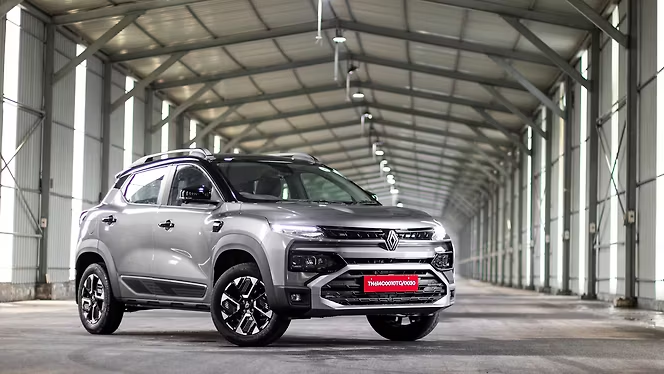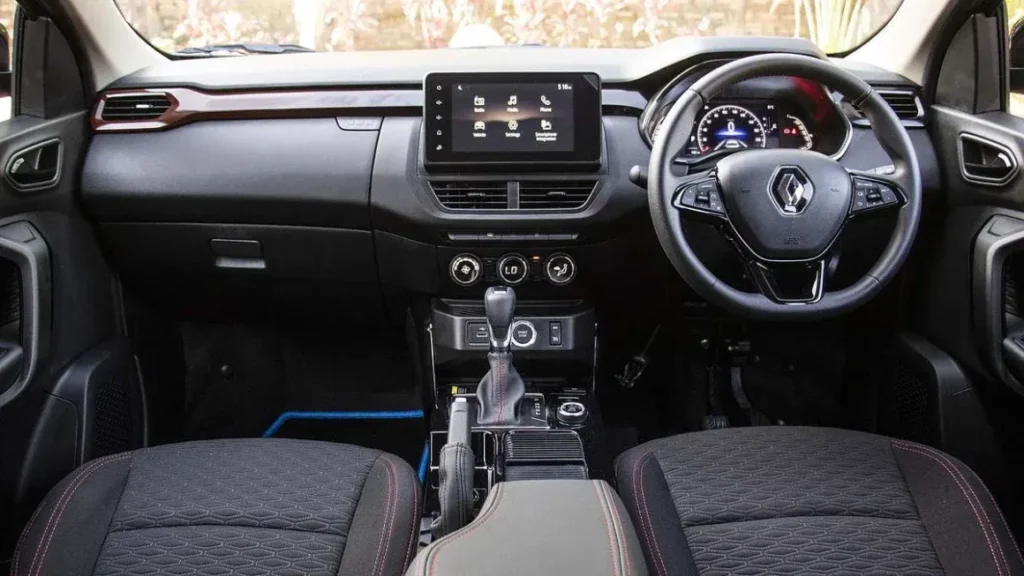The Renault Kiger is one of India’s most talked-about compact SUVs.
It blends sharp styling, roomy space and strong feature content.
The 2025 facelift refresh keeps the Kiger fresh and competitive.
This review explains the Kiger in simple words.
I focus on design, cabin, engines, ride, safety, fuel economy, variants, ownership and value for Indian buyers.
Short sentences and clear facts make it easy to read.
Quick spec table — Renault Kiger (India, 2025 facelift)
| Item | Renault Kiger (typical) |
|---|---|
| Segment | Compact SUV (B-SUV) |
| Engines | 1.0L NA petrol; 1.0L turbo petrol |
| Power | NA ~72 PS; Turbo ~100 PS |
| Torque | NA ~96 Nm; Turbo ~160 Nm |
| Transmission | 5-speed MT; CVT (turbo); AMT on some trims |
| Drivetrain | FWD |
| Mileage (claimed) | ~19–20 km/l (varies by engine & gearbox) |
| Ground clearance | ~205 mm |
| Boot space | ~ 405 litres (typical for segment) |
| Key features | 8″ touchscreen, digital cluster, 360° camera (top), 6 airbags (many trims), ESC, ventilated seats |
| Price (ex-showroom) | From ~₹6.29 lakh to ~₹11.29 lakh (trim/engine dependent) |
Quick overview — what’s new for 2025

The 2025 Renault Kiger received a mid-life facelift.
Renault updated the front end, lighting and interior trim.
Features such as ventilated seats and a 360-degree camera are now on higher trims.
Renault also made safety a priority, adding more airbags and electronic aids on many variants.
The updated Kiger launched with prices starting around ₹6.29 lakh (ex-showroom) in India. The Times of India
Design and road presence
The Kiger looks bold for its size.
The facelift adds a sharper grille and a modern headlamp design.
The front bumper and fog lamp housings are restyled.
From the side, the Kiger has a high belt line and flared wheel arches.
The roof rails, skid plates and alloy wheels give it an SUV stance.
At the rear, the new light graphics lift the overall look.
Overall, it looks bigger and fresher than many rivals in the same price group.
Cabin layout, materials and comfort

Open the door and the Kiger feels practical.
The new cabin trim uses better plastics in visible spots.
Seats get improved upholstery on mid and top trims.
The dashboard layout is simple and logical.
Controls are easy to reach and use while driving.
Higher trims add ambient lighting and leatherette touches.
Rear legroom is generous for this class. Two adults travel comfortably over long trips.
Boot space is useful for family luggage and daily shopping.
Small storage bins and door pockets add everyday convenience.
Also Read Nissan Magnite Review 2025: A Budget-Friendly Compact SUV with Big Features
Infotainment and connected features
Renault offers a modern touchscreen on the Kiger.
The system supports Android Auto and Apple CarPlay.
Higher trims get a larger, clearer display and added menus.
The digital instrument cluster shows trip and fuel data simply.
Top trims also offer a 360-degree camera and wireless phone charging.
Renault gives connected-car services on selected variants.
These features make the Kiger feel like an up-to-date compact SUV.
Engines, gearbox and performance
The Kiger comes with two petrol engines.
The first is a 1.0-litre naturally aspirated petrol.
It makes roughly 72 PS and is tuned for city use.
This engine is light on fuel and easy to drive in traffic.
The second is a 1.0-litre turbo-petrol unit.
It produces about 100 PS and much stronger torque.
This turbo motor is lively on highways and during overtakes.
You can get it with a 5-speed manual or a CVT automatic in higher trims.
The CVT version gives smooth acceleration in traffic and on open roads. CarWale
Real-world drive impressions are simple.
In the city the NA engine is calm and frugal.
The turbo offers better response when the car is loaded or on steep slopes.
The CVT helps remove gearshifts in slow traffic.
If you drive long distances often, the turbo manual or turbo-CVT is the smarter pick.
Ride, handling and NVH
Renault tuned the Kiger for comfort.
The suspension soaks small potholes well.
It keeps the car composed on broken city roads when you drive sensibly.
At high speeds the Kiger feels stable for its size.
The steering is light and helps with parking and lane changes.
Tyre and wind noise rise at higher speeds, especially in lower trims with basic insulation.
Top trims with better tyres and damping feel quieter and more refined.
Safety — big step forward
Safety is a strong selling point in the 2025 model.
Renault has added more airbags and electronic aids across the range.
The facelifted Kiger now has six airbags on many variants.
It also gets ESC (electronic stability control), traction control and ISOFIX child anchors on selected trims.
Global NCAP crash tests gave the Kiger a good adult occupant score and a mixed child protection score.
Overall, Renault improved the Kiger’s safety to make it a more trusted family car. carandbike+1
Mileage and running costs
Fuel economy is one of the Kiger’s strengths.
Claimed figures are competitive for the class.
The turbo petrol with manual gearbox posts good numbers on open roads.
In real life, expect mid to high teens km/l in mixed use with the turbo motor.
City figures will be lower in heavy traffic.
The NA petrol returns slightly higher fuel economy in gentle city driving.
Service and parts cost remain affordable compared with premium brands.
Overall ownership costs are reasonable for a compact SUV.
Variants, features and pricing
Renault sells the Kiger in multiple trims to suit budgets.
The 2025 lineup typically includes Authentic, Evolution, Techno and Emotion grades.
Feature sets rise predictably up the range.
Base trims give the essentials. Mid trims offer good convenience and safety items. Top trims bundle premium touches such as ventilated seats, full LED lighting and a 360° camera.
Prices begin at about ₹6.29 lakh and extend into the ₹11 lakh band for fully loaded turbo variants, depending on city and variant choice. The Times of India+1
Practical ownership notes for Indian buyers
The Kiger’s compact size helps in congested cities.
Ground clearance is competitive and helps clear speed breakers.
Renault service network is growing; check dealer reach in your town.
Warranty and periodic service plans are available.
For long-term value, choose a variant that suits your routine.
If you do city runs mostly, the NA petrol or CVT may be fine.
If you do frequent highway trips, pick the turbo manual or CVT for better overtakes and steady cruising.
How the Kiger stacks up against rivals
The Kiger competes with many compact SUVs in India.
Rivals include the Kia Sonet, Hyundai Venue, Tata Nexon, MG Astor and Nissan Magnite.
Kiger’s strengths are price, features and rear seat space.
Its safety upgrades move it ahead in occupant protection.
Some rivals may offer stronger NVH control or more premium cabins in top trims.
If you want an affordable, well-equipped and safe compact SUV, the Kiger is a strong choice.
Pros and cons — quick summary
Pros
- Strong value for money.
- Roomy rear seats for the class.
- Good safety upgrades and Global NCAP performance.
- Multiple engine and gearbox choices.
- Modern looks and useful features in higher trims.
Cons
- NVH is average at high speeds in lower trims.
- Some rivals offer softer ride or more premium cabin feel.
- Child occupant protection still lags top score levels.
Frequently asked questions (FAQs)
1. What is the starting price of the Renault Kiger 2025 facelift?
The facelifted Kiger launched at about ₹6.29 lakh ex-showroom in India. Higher trims cost more depending on engine and options. The Times of India
2. Which Kiger should I pick — NA petrol or turbo?
If you mainly drive in the city, the NA petrol is economical and simple. If you do highway runs or want stronger pull, choose the turbo petrol with manual or CVT.
3. Is the Kiger safe for family use?
Yes. Renault improved safety in 2025. The Kiger has more airbags, ESC and modern aids. Global NCAP gives it a solid adult occupant score. Still, child protection has room to improve. carandbike
4. What real-world mileage can I expect?
Expect mid-teens km/l in mixed driving with the turbo unit and slightly higher with the NA petrol in mild city use. Highway figures can be better when driven gently. CarDekho
5. How does it compare to the Kia Sonet or Hyundai Venue?
The Kiger often undercuts rivals on price while offering high feature value. Rivals may beat it on refinement and perceived cabin quality. Choose based on which features and driving feel matter most to you.
Conclusion — who should buy the Renault Kiger?
The Renault Kiger 2025 facelift is a sensible choice for Indian buyers who want space, features and strong safety at a fair price.
It is a good family car for city and highway use.
The range of engines and gearboxes gives you options for different use patterns.
If you want the best mix of safety and features without paying premium SUV prices, the Kiger deserves a test drive.
As always, try the variant you plan to buy. Check the dealer’s final on-road price and available service plans. That will help you make a well-informed decision.


















